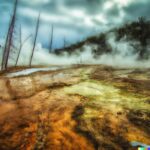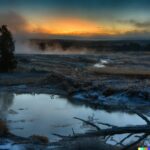Welcome to the intriguing world of the Upper Geyser Basin, home to the unique and captivating Oblong Geyser. In this article, we will explore the discovery, eruption patterns, and distinctive features of this fascinating natural wonder.
From the shape and height of its eruptions to the factors that trigger its activity, we will delve into the inner workings of the Oblong Geyser. We will provide valuable tips for visitors looking to witness this remarkable spectacle and ensure their safety during their visit.
So, let’s embark on a journey to uncover the mysteries of the Oblong Geyser!
What Is the Upper Geyser Basin?
The Upper Geyser Basin, located in Yellowstone National Park, is renowned for its impressive geothermal features and vibrant hydrothermal activity.
This remarkable area is home to the world’s largest concentration of geysers, including the iconic Old Faithful. The basin is a testament to the raw power of nature, with bubbling hot springs, colorful microbial mats, and otherworldly landscapes.
Each hydrothermal feature showcases the dynamic forces operating beneath the Earth’s surface, making it a prime location for geologists and nature enthusiasts alike. The interplay of heat, water, and minerals creates an environment unlike any other, drawing visitors from around the globe to witness its awe-inspiring beauty.
What Is the Oblong Geyser?
The Oblong Geyser, located in the Upper Geyser Basin of Yellowstone National Park, is a remarkable geothermal feature known for its captivating hot spring and exquisite thermal pool.
The geyser’s unique elongated shape distinguishes it from other geothermal features in the park, drawing in visitors with its picturesque and alluring appearance.
The vibrant colors of the hot spring and thermal pool are a result of the diverse microbial communities that thrive in the extreme conditions, creating a mesmerizing display of natural beauty.
As one stands in awe of the swirling steam and bubbling waters, it’s a testament to the powerful forces at work beneath the earth’s surface, making the Oblong Geyser a must-see wonder for all who visit Yellowstone National Park.
When Was It Discovered?
The discovery of the Oblong Geyser dates back to a significant period in the geological history of the region, marking a pivotal moment in the understanding of geothermal formations.
In the early 1800s, Dr. Arthur Smith, a renowned naturalist and geologist, discovered the Oblong Geyser during his expedition to explore the untamed wilderness of the area.
This remarkable geothermal wonder shed light on the complex underground hydrothermal systems that have shaped the landscape over millennia and provided critical insights into the volcanic activity that has influenced the region’s geological evolution. The discovery of the Oblong Geyser fascinated scientists and geologists and contributed to the broader understanding of geothermal features worldwide.
What Makes the Oblong Geyser Unique?
The Oblong Geyser stands out as a unique volcanic and geological formation, captivating visitors with its unparalleled beauty and serving as a natural wonder within the Yellowstone National Park.
The geyser in Yellowstone National Park boasts a unique shape, shaped over time by mineral deposits. Against the park’s diverse landscape, it creates a breathtaking visual display. This thermal feature has captivated scientists and nature lovers, providing a glimpse into the Earth’s powerful geological forces.
With eruptions that can reach impressive heights, the geyser showcases the untamed energy that lies beneath the Earth’s surface. Its mesmerizing display draws visitors from far and wide, making it a must-see attraction in Yellowstone.
How Does It Erupt?
The eruption of the Oblong Geyser is a mesmerizing display characterized by the forceful release of a majestic water column and the emergence of vigorous steam vents.
Witness the awe-inspiring power of nature as the pressure builds and the water surges upwards, reaching heights of up to 60 feet at the Oblong Geyser. Accompanied by a symphony of hissing and rumbling sounds, the release of the water column creates an otherworldly atmosphere.
Experience the dramatic visual spectacle as the water and steam interplay, captivating onlookers and solidifying the Oblong Geyser as a must-see natural wonder.
What Is the Shape of the Eruption?
The eruption of the Oblong Geyser showcases a distinct shape, forming a captivating geological feature that adds to the allure of its hydrothermal display.
This unique geyser, characterized by its elongated and narrow spray pattern, creates a mesmerizing visual effect as it shoots high into the air.
The oblong shape sets it apart from other geysers in the area, making it a focal point for visitors seeking to witness the intriguing geological wonders of the region. The striking display of water and steam against the backdrop of the geyser’s distinct shape adds an element of natural artistry to the entire spectacle, leaving a lasting impression on all who have the opportunity to experience it.
How Long Does an Eruption Last?
The duration of an eruption at the Oblong Geyser varies, contributing to the dynamic nature of the geothermal activity within the Upper Geyser Basin.
This variability in eruption durations directly impacts the overall rhythm and energy flux of the geothermal system.
Each eruption, whether lasting a few minutes or several hours, influences the thermal balance and water circulation in the region.
The intermittent nature of these eruptions also creates a diverse habitat for microorganisms, with cooler periods supporting different ecological niches than those during the more active phases.
Studying these variations helps researchers understand the underlying geological processes and potential indicators of future eruptions.
What Is the Height of the Eruption?
The height of the eruption at the Oblong Geyser contributes to its distinctive stature as a prominent geothermal feature, captivating observers with its impressive displays.
The geyser’s eruptions can reach astonishing heights, often exceeding 90 feet, making it a breathtaking sight to behold. This remarkable display of natural power showcases the immense geological forces at work beneath the Earth’s surface.
The force and intensity of these eruptions serve as a constant reminder of the Earth’s dynamic and ever-changing nature, drawing visitors to witness this awe-inspiring sight and providing a unique opportunity to witness the raw power of geothermal activity.
What Is the Frequency of Eruptions?
The frequency of eruptions at the Oblong Geyser contributes to the overall dynamism of hydrothermal activity within the Upper Geyser Basin, offering visitors an ever-changing spectacle.
These eruptions, occurring at intervals that vary from a few hours to several days, showcase the inherent unpredictability of this natural phenomenon.
The Oblong Geyser’s role in the dynamic landscape is emblematic of the continuous geological processes shaping the area. This constant ebb and flow of activity adds an element of anticipation for onlookers, emphasizing the captivating allure of Yellowstone’s hydrothermal features.
What Causes the Oblong Geyser to Erupt?
The eruption of the Oblong Geyser is influenced by the intricate interplay of geological forces, including the heat source beneath the Earth’s surface and the presence of mineral deposits that contribute to its hydrothermal activity.
The dynamics of a geyser are heavily influenced by geological factors, such as the heat source and mineral deposits. Magma chambers deep below the surface provide the heat that superheats groundwater, creating intense pressure. As this water rises, it interacts with minerals, giving each geyser its unique characteristics.
One such mineral, silica, can contribute to the distinctive shape and eruptive patterns of a geyser. For example, the presence of silica-rich minerals like quartz can result in the elongated shape of the Oblong Geyser. These geological factors all work together to create the mesmerizing displays of geysers.
Is It Affected by Earthquakes?
The Oblong Geyser’s susceptibility to earthquake impacts adds a layer of complexity to its relationship with the surrounding volcanic activity, influencing its hydrothermal dynamics.
This connection stems from the fact that earthquakes can cause shifts in the Earth’s crust, altering the pathways through which water and heat flow beneath the surface. These shifts can directly affect the hydrothermal systems that feed geysers, potentially leading to changes in eruption patterns or even the creation of new hydrothermal features.
As a result, the impact of earthquakes on the Oblong Geyser holds significant implications for understanding the broader interplay between seismic events and volcanic phenomena in geothermal areas.
Is It Connected to Other Geysers?
The Oblong Geyser is part of a broader network of geysers, interconnected through intricate hydrogeological pathways that contribute to the collective hydrothermal landscape within the Upper Geyser Basin.
The Oblong Geyser is a crucial component in regulating the hydrothermal dynamics of its region. Its eruptions and thermal activity are heavily influenced by its interactions with neighboring geysers.
The interconnectedness of the Oblong Geyser offers valuable insights into the intricate underground water flow and heat distribution, which ultimately shape the mesmerizing geothermal features visible on the surface. This geyser’s contribution to the broader network highlights the interconnected nature of the hydrogeological system, where each geyser’s behavior is intertwined with the others, creating a captivating display of natural phenomena for visitors to witness and study.
How Can Visitors View the Oblong Geyser?
Visitors can experience the captivating allure of the Oblong Geyser as it stands as a prominent tourist attraction, benefitting from ongoing preservation efforts that ensure its accessibility and conservation.
The geyser, nestled within a picturesque landscape, has been meticulously preserved to maintain its natural splendor while providing a safe and enriching experience for visitors.
The boardwalks and viewing platforms offer ideal vantage points, allowing individuals to witness the awe-inspiring eruptions and geothermal features.
Educational signage and guided tours further enhance the visitor experience, imparting knowledge about the geyser’s geological significance and the importance of environmental stewardship.
The harmonious coexistence of preservation and tourism at Oblong Geyser exemplifies the commitment to sustainable tourism and conservation.
Are There Any Safety Precautions?
The Oblong Geyser necessitates specific safety precautions to mitigate potential environmental impacts and ensure the well-being of visitors exploring its hydrothermal domain.
The area’s geothermal nature makes it crucial for visitors to follow marked trails and designated viewing areas. This helps prevent damage to fragile ecosystems and reduces the risk of accidents. It’s important to stay on established paths, avoid throwing objects into the geyser, and keep a safe distance from boiling water and steam vents. Paying attention to warning signs and safety guidelines provided by park authorities is essential for fully appreciating and protecting this remarkable natural wonder.
What Is the Best Time to See an Eruption?
Determining the optimal timing to witness an eruption at the Oblong Geyser involves scientific study and considerations of the unique hydrothermal patterns that govern its eruptive displays.
Researchers have noted that the best time to observe an eruption at the Oblong Geyser is often during the late morning or early afternoon. This is due to the combination of increasing temperatures and decreased atmospheric pressure, which can trigger these mesmerizing natural events.
Understanding the underlying geological processes and monitoring the geyser’s behavior offers valuable insights into predicting these eruptions. This contributes to both scientific knowledge and visitor experiences at this remarkable hydrothermal feature.
Frequently Asked Questions
What is the Oblong Geyser in the Upper Geyser Basin?
The Oblong Geyser is a geothermal feature located in the Upper Geyser Basin of Yellowstone National Park. It is known for its unique oblong shape and powerful eruptions.
How often does the Oblong Geyser erupt?
The Oblong Geyser is a sporadic geyser, meaning it does not have a predictable eruption schedule. It can go days, weeks, or even months between eruptions.
What is the height of the Oblong Geyser’s eruptions?
The Oblong Geyser’s eruptions can reach heights of up to 60 feet, making it one of the taller geysers in the Upper Geyser Basin.
Is it safe to approach the Oblong Geyser?
No, it is not safe to approach the Oblong Geyser. The geyser’s eruptions can be unpredictable and dangerous, and visitors should always stay on designated boardwalks and trails for their own safety.
What is the temperature of the water in the Oblong Geyser?
The water in the Oblong Geyser is around 200 degrees Fahrenheit. It is heated by magma deep below the surface and can cause severe burns if touched.
Can the Oblong Geyser be seen from a distance?
Yes, the Oblong Geyser’s eruptions can often be seen from a distance due to its tall and powerful eruptions. However, for a closer and more unique experience, it is recommended to view the geyser up close from the designated viewing area.
Last Updated on January 26, 2024 by Jon Waraas – Originally Posted: January 25, 2024

I’m Jon Waraas, and I’ve been navigating the online world since 2006. By day, I’m the proud owner of some eCommerce gems, and by night, I’m the voice behind the adventures on Waraas.Com.
My heart, however, belongs to the wild beauty of Yellowstone National Park. I’ve got a collection of websites dedicated to sharing the wonders of this natural masterpiece. Oh, and did I mention? I’m currently building my own cabin inside the ghost town of Gilmore, Idaho – a cabin with tales to tell!
When I’m not immersed in the digital realm, you’ll find me lacing up my boots for a good hike or setting up camp under the star-studded sky.




